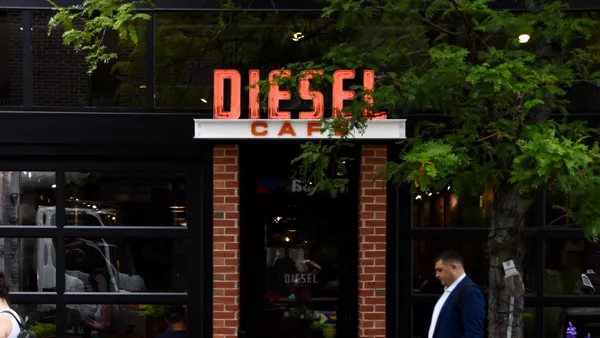Dive Brief:
- If stay-at-home orders were lifted tomorrow, roughly 66% of consumers wouldn't be willing to eat in a restaurant’s dining room, according to new research from Washington State University’s Carson College of Business emailed to Restaurant Dive. Only 21% of respondents feel ready to dine in as soon as dining room restrictions are lifted.
- Almost 50% of respondents indicated that they would wait at least one to three months or more to dine in with another person, but casual dining and family-style restaurants are the first they said they would patronize.
- Visible sanitation efforts, including hand sanitizer stations, servers wearing masks and cleaning tables and chairs in front of customers, will be the most important safety precautions diners will expect from restaurants, according to the research.
Dive Insight:
Though many restaurants are chomping at the bit for states to lift shelter-in-place orders, these rollbacks may not provide the immediate relief they need after taking a hard financial hit during the novel coronavirus pandemic. The U.S. is in the early stages of reopening, with 38 states allowing restaurants to reopen dining rooms in some capacity or planning to do so in the near future. In some of these states, however, the number of confirmed cases of COVID-19 continues to rise, and as of late May, there are more than 1.6 million confirmed cases in the U.S. with roughly 100,000 fatalities. For diners who are high-risk or who have close contact with high-risk individuals, this trend may simply be too daunting to justify returning to normal restaurant patterns.
The World Health Organization has warned that this is only in the first wave of COVID-19 and that a second peak of cases is possible as consumers return to daily life and the virus continues to spread.
When it comes to restaurant chains that have reopened, some are following rules that limit the number of guests in the dining room, require masks, and space guests at the same table at least six feet apart. Some are also using single-serve flatware and are screening guests for symptoms of illness such as fever before allowing them inside, like Chuck E. Cheese. These measures will likely ease the worry of some consumers who are on the fence about returning to dine-in service. A number of restaurants have even reconfigured their dining rooms to make social distancing practices easier to adopt.
More information is emerging regarding how the disease is transmitted, including a study showing that the virus can remain suspended in the air for as long as 14 minutes. Considering that diners will need to remove masks to eat their food, some consumers may simply be unwilling to take this risk, which could potentially slow restaurant's economic recovery.













